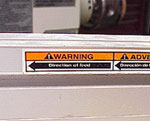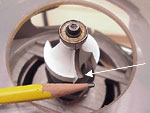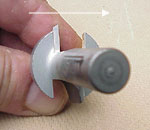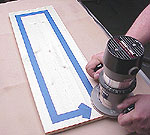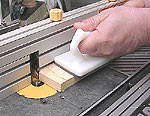This is a Veteran Owned site
Feed Direction
Confusion is easy!Text and photos by Tom Hintz Considering that the router is one of the most popular woodworking tools, it is no surprise that questions regarding its use are common. Of nearly 300 email questions in my "hold" folder, 188 of them related to basic router use. What is especially interesting is that the majority of these questions involve feed direction and rates, both of which are crucial to safety and the quality of the cut. Feed Direction and DangerThe good news about feed direction is that with very few exceptions, the stock always moves against the rotation of the bit. The bad news is that making a mistake with feed direction can easily initiate a very dangerous kick out with little or no warning. Feeding the material against the rotation of the cutter affords control because the cutting action creates resistance to the force being applied by the operator to move the wood across the bit. This balance of forces makes controlling the wood much easier. If the wood is introduced in the same direction as the bit is rotating the cutting edges instantly become extraordinarily efficient high-speed power feeders that can suddenly eject the wood, leaving the operators empty hands dangerously close to the cutter. This situation is particularly dangerous because the force the operator was applying to the wood before it kicked out immediately causes the now empty hands to lurch toward the bit. Disaster can be the instantaneous result. Confusion Is EasyIt is apparent that the most frequent cause of feed direction errors is operator confusion regarding which side of the cutter, in relation to the operator, is turning which way. The router is the only commonly used wood working power tool that can be used with the cutter facing up in table-mounted situations, or down for hand-held operations. When router orientation is changed from bit up to bit down modes, the operator has to remember that feed directions change as well. For clarity in this story, the "rear" of the bit is the cutting edge farthest from the operator and the "front" refers to the edge closest to you. Consistent PracticesThe easiest way to reduce feed direction errors is to develop standard operating procedures used each time a task is performed. Taking the time to double check the feed direction before each operation is a very good habit to get into. Hand-Held Operations
I always start at the lower left corner of the piece when cutting the outside edge in the hand-held mode. The bit is spinning in a clockwise direction from my perspective so engaging the rear of the bit with the wood means the router always moves left to right and goes around the remaining sides of the piece in a counter clockwise direction. When routing an inside edge, like when cutting the inside edge of a frame or opening, I start at the upper left corner so the rear of the bit again engages the wood and the router moves left to right. The only difference is that when cutting the inside edge, continuing the left to right motion takes the router around the opening in a clockwise direction. Using the same starting point every time develops a habit that goes a long way towards preventing directional errors and the damage and danger that can create. The exception to this would be when therre are end grain sections that are to be routed. Generally, we route the end grain segments first, and then the rest of the piece so any chipping that occurs at the end grain is removed in the final passes. I usually do the end grain first, then start at my normal position and go all the way around the piece, including a second pass over the end grain segments, so I get nice clean transitions from one side to the other. Router Table OperationsSafety Note: Whenever routing pieces on a router table be sure to use proper push stick, pads or other safety equipment that keep your hands a safe distance from the cutter.
When the router is installed bit-end up in a router table, bit rotation from the operators perspective is counter-clockwise. When using a fence or miter guide, the edge of the cutter closest to the operator is used and the material is fed right to left. An exception is when cutting a centered slot in a piece of wood. The first pass is made by holding the wood against the fence and then plunging it down over the bit at the start point and then feeding the stock into the cutter from right to left. However, when the piece is reversed to make the second pass to center the slot, the rear edge of the bit is often doing the cutting. In this case, the piece has to be fed from left to right. When making this type of cut, I have found it safest to make the first pass (right to left) and then shut off the router. I reverse the work piece and hold it in position above the router bit to make sure which edge of the bit will be doing the cutting. If the rear edge of the bit is doing the cutting, the work piece has to be fed across it from left to right. It should be noted that cutting centered slots on a router table is always a difficult and somewhat dangerous operation. If you are at all unsure of your skills or safety equipment, make the slot by drilling holes at either end and then removing the material between them with a jig saw. Occasionally router bits equipped with bearings are used in the router table without the fence. We have to remember that the router bit rotation is counter clockwise and adjust feed directions accordingly. When the front edge of the bit is used, the stock is fed right to left. If the rear of the bit is engaged, feed direction is left to right. Remember to use the proper push sticks or pads to keep your hands far away from the bit. Without the fence, the bit will be totally exposed if the wood kicks out or breaks. Climb CuttingThere are two situations when climb cutting, moving the router in the same direction as the bit rotation is acceptable. Climb cutting is always difficult and care must be taken to maintain control of the router. The most common climb cut is on a dovetail jig with the router in the hand-held position. A small portion of the cutters edge is used to make a very light scoring cut, moving from right to left, to reduce tear out. Even though very little of the bit is engaged in the wood, care must be taken to maintain control of the router as it could want to accelerate down the wood. The other situation when climb cutting is used is when using some laminate trimmers. Feeding the router against the bit rotation sometimes causes these materials to "chip" ahead of the cutter. In these cases, the laminate is trimmed as close to the base material as possible with other tools and then the router can be used to clean the edge, moving it in the same direction as the bit rotation. Whenever climb cutting, whether on a dovetail jig or trimming laminates, keep the cuts very light and a firm grip on the router to avoid having it get away from you. Climb cutting without using proper procedures is very dangerous. Feed RatesDetermining the proper feed rate for any bit is relatively easy, assuming the router speed is set correctly for the bit. If the bit burns the wood, the feed rate is too slow. If the wood chips or blows out ahead of the bit, the feed rate is too fast. Granted these are generalizations and there are other factors that could contribute to these problems, but they remain important clues about what you may be doing wrong. Feed rates and bit performance are directly related to the depth of cut. Trying to remove too much material in a single pass can cause or increase burning and blow out ahead of the bit. It is always better to make multiple light cuts than fewer deeper cuts. Lighter cuts are far safer and produce much better results. The Bottom LineRouters extremely useful in the workshop, but they can also be very dangerous if used improperly, including the failure to employ adequate safety equipment, procedures and feed direction. If you find yourself faced with a router-related task that you do not completely understand or do not have the proper safety equipment for, the only prudent course of action is to stop! Wait until you get the information and equipment to make the operation safe. The task will be there later, your fingers may not. As with all power tools, the major cause of accidents is operator error. Not taking the time to be certain of feed direction with a router is dangerous, and could lead to severe injury. There are many woodworkers who have learned to pursue this hobby with a disability caused by a moment of lost concentration. Take the time to make sure you do not join those ranks. Other Router-Related StoriesReading the Grain |
||||||
Do you have a comment about this page? - Email Me! |
All written, photographic and drawn materials are property of and copyright by NewWoodworker.com LLC 2000-2019. Materials may not be used in any way without the written permission of the owner.


